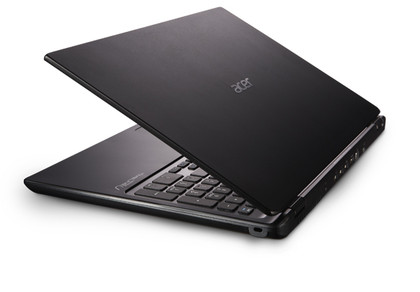TechRadar Verdict
Pros
- +
Excellent gaming performance
- +
Battery life
- +
Build quality
Cons
- -
Poor trackpad
- -
Low resolution screen
Why you can trust TechRadar
Nvidia has been calling the Acer Timeline U M3 the first true Ultrabook. And the big, green graphics giant has good reason to be backing this svelte-looking machine - at its heart beats the very latest in mobile graphics power, the GeForce GT 640M.
This is the big selling point for this otherwise rather middle-of-the-road machine, and without it there is no way we would be anywhere near as enamoured with it.
As a 15-inch notebook it's rather stretching the idea of the super-slim Ultrabook, and the screen sure is nothing to write home about. But, as it stands, we are rather taken by this laptop because of what the M3-581TG actually represents.
This slimline machine is a comparative gaming monster: when you put this ultra-portable notebook up against heavyweight gaming slabs from the likes of MSI and Asus, you realise it's just as capable of throwing up frame rates that are completely playable. And never before seen in a machine this thin.
Now this is no cumbersome gaming behemoth but a portable plaything in a very manageable form. We're not talking about quad-core processors or SLI graphics here, but rather a laptop that feels at home on your lap and one that can move more than a couple of feet from a power outlet.
So, aside from the new Nvidia GPU humming away inside this slimline Acer chassis, what else is helping to run the show?
This is the top-end version of the Aspire Timeline U M3, so it comes with an Intel Core i7-2637M CPU, a dual-core, HyperThreaded chip nominally running at 1.7GHz, 4GB DDR3 RAM and a 256GB SSD. All this running under the ubiquitous Windows Home Premium 64-bit.
Sign up for breaking news, reviews, opinion, top tech deals, and more.
For a standard Ultrabook those are pretty decent specs, but for a gaming laptop a 1.7GHz CPU is far from the norm. Still, Intel's Turbo Boost allows it to run at a rather more healthy 2.4GHz when it's being taxed.
Gimme GPU
As we've already alluded, this machine would be far less interesting if it wasn't for that graphics card, and it really is an impressive chip. Nvidia has been keen to stress that this 600 series generation of its GeForce graphics, in both mobile and desktop trim, is all about performance per watt. As such, you're not really getting any more performance than you would have seen in past mobile chips.
Indeed, the GTX 555M is still a faster graphics chip. What it does do, though, is run far leaner in terms of power draw. Thanks to the die shrink from 40nm transistors down to a miniscule 28nm, this is a much smaller chip, and therefore drinks a lot less juice.
That means it also puts less strain on the battery, but even more importantly it also produces much less heat. The cooler operating temperatures means that the GTX 640M doesn't need the scale of cooling solution the previous 40nm chips needed. Basically all this technical stuff means you can get decent, gaming-capable graphics performance from laptops like the M3 with much smaller footprints.
The Acer M3 is also running a relatively low-resolution screen - at 1,366 x 768 it's not hitting the full HD scale of more media oriented machines. But gaming is this notebook's raison d'être and keeping the native resolution low means this mid-range GPU can hit excellent frame rates on high settings.
As the saying goes, the proof is in the pudding and the eating - or in this case the proof is in the graphically intensive Battlefield 3 and the virtual murder of other gamers. The Acer M3 can run BF3 on Ultra settings, with GPU-stressing extras like anti-aliasing, and run like a dream. It's the smart combo of low native resolution and the Nvidia GPU that make this possible.
Frame rates do drop when you yank out the power cable, though, so you're going to have to drop the more intensive settings like anti-aliasing, but it will still keep the Nvidia GPU running. Unlike Alienware's M11x which relegates you to the Core i7's HD3000 GPU away from the plug socket...
Benchmarks
Battery Eater '05: 283 minutes
Cinebench: 8633
3DMark 2006: 8858
Ultraportable gaming

As a gaming laptop, this is a thing of beauty, but as a standard laptop there is definitely much room for improvement. For starters, you can't get away from just how awful the trackpad is.
As the main interaction with your notebook, the trackpad needs to stand up, but having the whole pad itself as a button is a recipe for disaster. In this machine it means you're constantly missing icons or Windows buttons, and makes right-clicking on anything a real lottery. It also feels rather flimsy, and doesn't seem to be sitting flat in its housing on our sample.
The chiclet keyboard isn't too bad though, and does aid the cooling of the machine's innards, but the short action still feels dead to the touch. That said, the keyboard does have space for the numeric side and there's enough space between keys to avoid many mis-types.
In the context of changing the scale of gaming laptops, these are minor problems. Being able to have a laptop on your lap while you're playing a game without melting the flesh from your bones, is real treat.
Battery life is pretty decent too, getting close to five hours. With the GPU taxing the battery though you're likely to be looking more at three hours, but that should take care of many a train journey while you journey through Skyrim.
